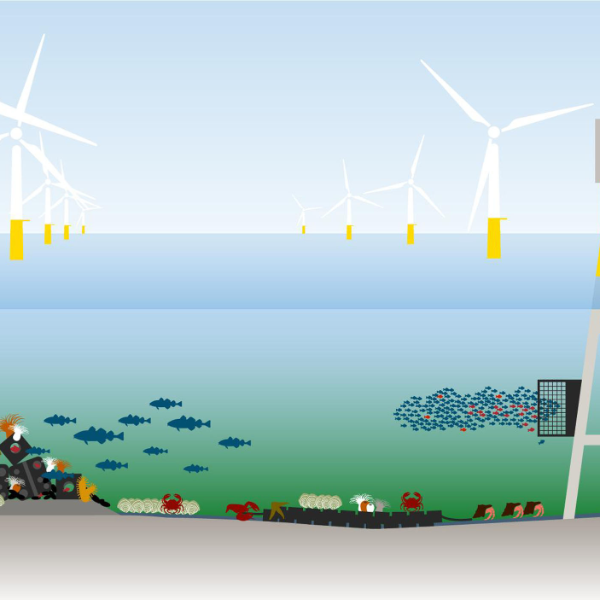Catalogue launched for designing nature inclusive offshore wind farms

Catalogue launched for designing nature inclusive offshore wind farms
To support wind farm permit holders to design their wind farms in a nature-inclusive way, a catalogue of nature-inclusive design options has been developed by Witteveen+Bos and Wageningen Marine Research. This catalogue shows relevant nature-inclusive design options for target species, the expected construction costs, and possible suppliers and manufacturers.
Demonstrable efforts required to enhance the marine ecosystem
The Dutch Government stimulates nature enhancement within offshore wind farms. Currently, permit holders must take measures to increase the suitable habitat for species naturally occurring in the North Sea. The focus of the study was therefore on native species that are under pressure, such as cod (Gadus morhua) and European oyster (Ostrea edulis). At the same time many other species can also benefit from the measures. In addition, the catalogue focusses on a number of commercial species such as Edible crab (Cancer pagurus) and European lobster (Homarus gammarus) since there is also a lot of focus on co-using offshore wind farms for small scale fisheries. The catalogue was commissioned by the Dutch Ministry of Agriculture, Nature and Food Quality.
Industry proofing
The practical question is: which options are there to enhance nature, and what do they cost? Project leader Ivana Prusina, marine ecologist at Witteveen+Bos, indicates that they have inventoried the current nature-inclusive design options that exist in other locations in the world. 'We then made a list of promising options in the context of the North Sea and discussed them with various offshore wind and construction companies. This ‘industry proofing’ process was a very insightful process. For example, by interviewing technical engineers from wind park developers, we quickly realised that adding constructions to the wind turbine itself (monopile) was not feasible at the moment and would require a whole new technical design of the wind turbine', said Prusina. For transformation stations this was less of a problem. Another aspect was the typical work flow in the field: in which order do construction vessels place scour protection, install wind turbines and so on? The addition of extra substrate or other construction measures should fit in this workflow to reduce costs and optimise production. For this reason, the researchers provided an overview of the different steps to be taken to include nature inclusive design in an offshore infrastructure design and give insight where the required information can be obtained.
Fish hotels and optimised scour protection
The options in the catalogue are divided into three different categories. The first category focuses on add-on options such as fish hotels made of a steel cage that can be attached to the underwater foundations of the transformation stations. The second category is optimised scour protection layer. Here the ecologists came up with eleven options. One is adapted scour protection with a mix of larger and smaller rocks to create shelter for cod and if desired also crabs and lobsters. Other options include artificial reefs, habitat pipes or oyster gabions that can be placed on top of the scour protection. The third category is optimised cable protection layer. These protective layers cover the cables that connect the turbines to the transformation station and the mainland. A nature inclusive design option for cable protection would be to use concrete mattresses with a modified concrete and complex structures. Construction costs were calculated for each nature inclusive design option.
Monitoring will result in potential biomass production
It is currently unknown what the nature-enhancing effect of nature-inclusive design options on the ecosystem is. Marine biologist Oscar Bos of Wageningen Marine Research explains: 'It is therefore sensible to set up a good monitoring program as soon as nature-inclusive measures have been taken so that we can learn and improve the design.'
Extensive spatial claim for offshore wind energy
In 2030, approximately 11 gigawatts of wind farms in the Dutch North Sea will be installed. This takes up the necessary space and that can interfere with the proper functioning of the ecosystem. However, the wind farms can help to actively enhance the ecosystem. Smart adaptations to the design of an offshore infrastructure can help to kickstart rehabilitation of degraded North Sea habitat. This is the idea behind the current government policy in the Netherlands. Wind farm permit holders are now looking for ways to design their wind farms in a nature inclusive way. This catalogue can support wind farm developers in making nature inclusive design a new standard in the offshore industry.
More information?






